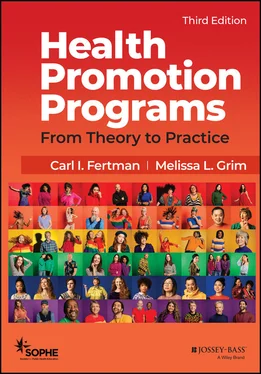(SOPHE) Society for Public Health Education - Health Promotion Programs
Здесь есть возможность читать онлайн «(SOPHE) Society for Public Health Education - Health Promotion Programs» — ознакомительный отрывок электронной книги совершенно бесплатно, а после прочтения отрывка купить полную версию. В некоторых случаях можно слушать аудио, скачать через торрент в формате fb2 и присутствует краткое содержание. Жанр: unrecognised, на английском языке. Описание произведения, (предисловие) а так же отзывы посетителей доступны на портале библиотеки ЛибКат.
- Название:Health Promotion Programs
- Автор:
- Жанр:
- Год:неизвестен
- ISBN:нет данных
- Рейтинг книги:5 / 5. Голосов: 1
-
Избранное:Добавить в избранное
- Отзывы:
-
Ваша оценка:
- 100
- 1
- 2
- 3
- 4
- 5
Health Promotion Programs: краткое содержание, описание и аннотация
Предлагаем к чтению аннотацию, описание, краткое содержание или предисловие (зависит от того, что написал сам автор книги «Health Promotion Programs»). Если вы не нашли необходимую информацию о книге — напишите в комментариях, мы постараемся отыскать её.
Health Promotion Programs: From Theory to Practice
Health Promotion Programs: From Theory to Practice
Health Promotion Programs — читать онлайн ознакомительный отрывок
Ниже представлен текст книги, разбитый по страницам. Система сохранения места последней прочитанной страницы, позволяет с удобством читать онлайн бесплатно книгу «Health Promotion Programs», без необходимости каждый раз заново искать на чём Вы остановились. Поставьте закладку, и сможете в любой момент перейти на страницу, на которой закончили чтение.
Интервал:
Закладка:
Healthcare Organizations
Healthcare organizations provide services and treatment to reduce the impact and burden of illness, injury, and disability and to improve the health and functioning of individuals. Healthcare practitioners work with individuals in community hospitals, specialty hospitals, community health centers, physician offices, clinics, rehabilitation centers, skilled nursing and long-term care facilities, and home health and other health-related entities. Traditionally, these sites are thought of as being part of the healthcare industry, which is one of the largest industries in the United States and provides 18 million jobs. The U.S. Department of Labor, Bureau of Labor Statistics (2020b) reports the healthcare and social assistance sector is expected to make up 40 percent, or 3.4 million, of the overall increase in employment from 2018 to 2028. Six of the 10 fastest-growing occupations from 2018 to 2028 are expected to be healthcare. The roughly 595,000 establishments that make up the healthcare industry vary greatly in size, staffing patterns, and organizational structures. About 76 percent of healthcare establishments are offices of physicians, dentists, or other health practitioners. Although hospitals constitute only 1 percent of all healthcare establishments, they employ 35 percent of all healthcare workers (OER, 2020). While health promotion programs might seem out of place in a treatment facility, in fact, much work is done in such facilities to reduce the negative consequences associated with disease.
Communities
Communities are usually defined as places where people live—for example, neighborhoods, towns, villages, cities, and suburbs. However, communities are more than physical settings. They are also groups of people who come together for a common purpose. The people do not need to live near each other. People are members of many different communities at the same time (families, cultural and racial groups, faith organizations, sports team fans, hobby enthusiasts, motorcycle riders, hunger awareness groups, environmental organizations, animal rights groups, and so on). These community groups often have their own physical locations (for example, community recreation centers, golf, swimming, and tennis clubs; temples, churches, and mosques; or parks). These affinity groups all exist within communities, as part of communities, and at the same time, they are their own community. Health promotion programs frequently seek out people both in the physical environment of the neighborhood where they live and within the affinity groups that they form and call their community.
Within a community, the local health department and community health organizations work to improve health, prolong life, and improve the quality of life among all populations within the community. Local and state health departments are part of the government’s efforts to support healthy lifestyles and create supportive environments for health by addressing such issues as sanitation, disease surveillance, environmental risks (for example, lead or asbestos poisoning) and ecological risks (for example, destruction of the ozone layer or air and water pollution). The staff at a local health department includes a wide variety of professionals who are responsible for promoting health in the community: public health physicians, nurses, public health educators, community health workers, epidemiologists, sanitarians, and biostatisticians.
Community health organizations have their roots in local community members’ health concerns, issues, and problems. These organizations work at the grassroots level, frequently operating a range of health promotion programs that target community members. In this text, the term community health organization is synonymous with the terms community agency , program , initiative , human services , and project . Some community health organizations do not choose to use these terms in their names, deciding to use a name that reflects whom they serve, the health issue they address, or their mission—for example, the American Cancer Society, Caring Place, Compass Mark, Youth Center, Maximizing Adolescent Potentials, Bright Beginnings, Strength and Courage, Healthy Hearts, or Drug Free Youth. Regardless of their names, the common bond for community health organizations is their shared health focus.
Workplaces
Workplaces are anywhere that people are employed—business and industry (small, large, and multinational), governmental offices (local, state, and federal), schools, universities, community based organizations, and healthcare organizations. It has become increasingly clear that it makes financial sense to encourage and support employees’ healthy practices. Employers, both on their own initiative and because of the Affordable Care Act and federal regulations administered by the Occupational Safety and Health Administration, have been active in creating healthy and safe workplaces. As employers become aware that behaviors such as smoking, lack of physical activity, and poor nutritional habits adversely affect the health and productivity of their employees, they are providing their employees with a variety of workplace–based health promotion programs. These programs have been shown to improve employee health, increase productivity, and yield a significant value for employers (Fertman, 2015; National Institute for Occupational Safety and Health, 2021).
Stakeholders in Health Promotion Programs
Stakeholdersare the people and organizations that have an interest (i.e. a stake) in the health and programs of a specific group or population of people. First and foremost are the program participants, also called the priority population (for example, students, employees, community members, patients). The program is for their benefit and works to address their health concerns and problems. Although the authors of this book believe that the audience of any health promotion initiative should be regarded as the primary stakeholders, the term stakeholders traditionally has referred to other stakeholder groups that also have an interest in a program—for example, top civic, business, or health leaders in the community. The term stakeholders may also be used to describe the sponsoring organization’s executives, administrators, and supervisors; funding agencies; or government officials. In other words, stakeholders in a health promotion program are people who are directly or indirectly involved in the program.
Involving Stakeholders
Involving the stakeholders in a health promotion program is essential for its success. Involvement creates value and meaning for the stakeholders—for example, enlisting stakeholders to assist in identifying a program’s approaches and strategies in order to ensure congruence with stakeholders’ values and beliefs will strengthen stakeholders’ commitment to the program. Different stakeholders have different roles. Some stakeholders might help to define what is addressed in a program by sharing their personal health needs and concerns. Other stakeholders might offer services and activities in conjunction with the program (service collaborators). Stakeholders might serve as members of a program’s advisory board or as program championsor advocates, roles that are often essential in creating successful health promotion programs.
Advisory Boards
Most health promotion programs form some type of advisory board or advisory group (also sometimes called a team , task force , planning committee , coalition , or ad hoc committee ) to provide program support, guidance, and oversight throughout the program planning, implementation, and evaluation process. For example, during planning, advisory board members are involved with determining program priorities as part of the needs assessment, developing program goals and objectives, and selecting program interventions. During implementation, they might participate in the initial program offering, program participant recruitment, material development, advocacy, and grant writing. During evaluation they often review reports and give feedback on how best to disseminate and use the evaluation results and findings. Some advisory boardsare formal, with bylaws, regular meeting schedules, member responsibilities, and budgets. Others are informal, perhaps without any meetings but acting instead as a loose network of individuals who will offer advice and information when called upon by program staff.
Читать дальшеИнтервал:
Закладка:
Похожие книги на «Health Promotion Programs»
Представляем Вашему вниманию похожие книги на «Health Promotion Programs» списком для выбора. Мы отобрали схожую по названию и смыслу литературу в надежде предоставить читателям больше вариантов отыскать новые, интересные, ещё непрочитанные произведения.
Обсуждение, отзывы о книге «Health Promotion Programs» и просто собственные мнения читателей. Оставьте ваши комментарии, напишите, что Вы думаете о произведении, его смысле или главных героях. Укажите что конкретно понравилось, а что нет, и почему Вы так считаете.












